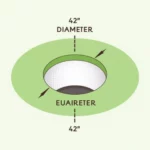When you step onto a golf course, you may not think much about the size of a golf hole, but this seemingly minor detail plays a crucial role in the game. Whether you’re a seasoned golfer or just starting out, understanding the dimensions of a golf hole can enhance your appreciation for the sport. Let’s dive deep into the ins and outs of golf holes, their sizes, and why they matter!
What is the Standard Size of a Golf Hole?
The standard size of a golf hole is 4.25 inches (108 mm) in diameter. This measurement was established by the United States Golf Association (USGA) and is used in most professional and recreational golfing events.
| Golf Hole Size | Measurement |
|---|---|
| Diameter | 4.25 inches (108 mm) |
| Depth | 4 inches (100 mm) |
| Standard cup depth | Unavailable for amateur play |
Why 4.25 Inches?
This size might seem arbitrary, but it has roots in the history of the game. Initial golf hole sizes varied, but as the sport grew in popularity, a standard was needed to ensure fairness and consistency in gameplay. The 4.25-inch diameter was established over a century ago, making it a hallmark of traditional golf.
 Golf Hole Dimensions
Golf Hole Dimensions
Understanding the Depth
While the diameter grabs most of the attention, the depth of a golf hole is also important. Standard golf holes are dug to a depth of 4 inches (100 mm). This depth allows for the flagstick and provides enough room for a golf ball to land and remain in the hole without immediately rolling back out.
It’s essential for players to know both the diameter and depth as this can influence putting techniques and strategies.
The Importance of Golf Hole Size in Gameplay
Now that we’ve covered the basic measurements, let’s explore why the size of a golf hole is integral to the game.
1. Skill Development
- Putting Practice: Understanding the size of the hole helps golfers practice their putting more effectively. Knowing the exact dimensions can assist in visualizing the target.
- Distance Control: When players are keenly aware of the hole’s dimensions, they can better gauge their distance and power while putting.
2. Game Standards
- Uniformity: A standardized hole size ensures that all players compete under the same conditions, regardless of the golf course’s location.
- Fair Play: Consistency across golf courses adds fairness, making it easier to compare scores among different courses and conditions.
3. Psychological Element
- Perception: Interestingly, the size of a golf hole can influence a golfer’s perception. A standard 4.25-inch hole can mentally create a target for a player, while the pressure of sinking a putt can heighten even further if other influencing factors are involved (e.g., distance from the hole, the slope of the green, etc.).
 Golfer Putting on Green
Golfer Putting on Green
Tips for Sinking Putts
Once you understand the importance of a golf hole’s size, consider these tips for successfully sinking more putts:
- Visualize Your Line: Picture the line the ball will take as it rolls toward the hole.
- Practice Different Distances: Use drills that allow you to practice at varying lengths to get accustomed to the hole’s size.
- Focus on the Hole: Keep your eyes on the hole. This may help you avoid distractions and maintain your intent.
Golf Hole Sizes Around the World
Most of the golf holes worldwide follow the USGA’s guidelines, but variations exist, particularly in informal or local competitions. While the standard size remains 4.25 inches, hole sizes can be altered for fun or challenge, especially in casual settings.
- Miniature Golf Holes: Typically 10-12 inches in diameter, allowing for more creative designs.
- Custom or Challenge Holes: Some courses may design larger holes to cater to novice golfers or for specific events.
Common Misconceptions about Golf Holes
1. Bigger Holes = Easier Game
While bigger holes might seem easier, they can reduce the challenge that many golfers relish. Think of it as the difference between casual play and competitive environments.
2. Golf Hole Size Affects All Aspects of Play Equally
Although the hole size is essential, other elements like green speed and placing significantly affect the game. Often, the difficulty arises not just from the hole’s size but environmental factors that affect the ball’s trajectory.
 Golf Course Obstacles
Golf Course Obstacles
Innovations in Golf Hole Design
Curious advancements in golf technology have led to an interest in rethinking hole design:
- Smart Holes: These equipped holes can offer feedback on ball entry speed and angle.
- Light-Up Holes: Some modern designs incorporate LED lights, making night golf more appealing.
These innovations can modernize a player’s experience while maintaining the sport’s integrity.
Key Takeaways
- The standard size of a golf hole is 4.25 inches in diameter and 4 inches deep.
- A uniform hole size contributes to fair play and skill development.
- Understanding the specifications can help golfers improve their techniques and approach.
- Innovations in hole design could lead to exciting developments in the sport.
Frequently Asked Questions (FAQ)
1. Why is the golf hole size standardized?
Standardization ensures consistency and fair competition across different courses.
2. What are the dimensions of a golf hole?
A standard golf hole measures 4.25 inches in diameter and 4 inches deep.
3. Can golf hole sizes vary?
Yes, while the standard size is 4.25 inches, casual or novelty holes may differ significantly.
4. How can I improve my putting skills?
Practicing different lengths, visualizing your line, and focusing on the hole can help.
5. Are there any innovative golf hole designs?
Yes, advancements include smart holes that provide feedback on the ball’s performance and light-up holes for night golfing.
6. Do all golf courses use the same hole size?
Yes, professional courses typically adhere to the USGA’s guidelines, but amateur or local courses may vary.
7. What happens if a ball rolls out of the hole?
It typically counts as missed unless specific rules apply, such as during playful rounds or friendly matches.
8. Does the size of the hole affect gameplay?
While it presents a target, several factors really impact gameplay, including the green’s condition and slope.
9. Why is putting so crucial in golf?
Putting often accounts for nearly half of your strokes during a round, making it a vital skill to master.
10. Are there regulations for hole modifications?
Yes, while innovations exist for entertainment, regulations must be followed in competitive play.
Understanding the size of a golf hole is more than just a trivial fact; it is part and parcel of what makes golf enjoyable and challenging. So, the next time you line up a putt, remember the significance of that small but mighty hole!

